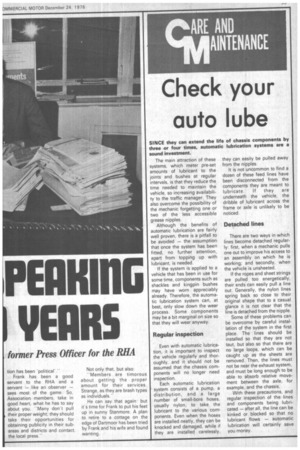CiA IRE AND AINTENANCE
Page 35

If you've noticed an error in this article please click here to report it so we can fix it.
Check your auto lube
SINCE they can extend the life of chassis components by three or four times, automatic lubrication systems are a sound investment.
The main attraction of these systems, which meter pre-set amounts of lubricant to the joints and bushes at regular intervals, is that they reduce the time needed to maintain the vehicle, so increasing availability to the traffic manager. They also overcome the possibility of the mechanic forgetting one or two of the less accessible grease nipples.
Although the benefits of automatic lubrication are fairly well proven, there is a pitfall to be avoided — the assumption that once the system has been fitted, no further attention, apart from topping up with lubricant, is needed.
If the system is applied to a vehicle that has been in use for some time, components such as shackles and kingpin bushes may have worn appreciably already, Therefore, the automatic lubrication system can, at best, only slow down the wear process. Some components may be a bit marginal on size so that they will wear anyway.
Regular inspection
Even with automatic lubrication, it is important to inspect the vehicle regularly and thoroughly, and it should not be assumed that the chassis components will no longer need inspection.
Each automatic lubrication system consists of a pump, a distribution, and a large number of small-bore hoses, usually nylon, to take the lubricant to the various components. Even when the hoses are installed neatly, they can be knocked and damaged, while if they are installed carelessly, they can easily be pulled away from the nipples.
It is not uncommon to find a dozen of these feed lines have been disconnected from the components they are meant to lubricate. If they are underneath the vehicle, the dribble of lubricant across the frame or axle is unlikely to be noticed.
Detached lines
There are two ways in which lines become detached regularly: first, when a mechanic pulls one out to improve his access to an assembly on which he is working; and secondly, when the vehicle is unsheeted.
If the ropes and sheet strings are pulled too energetically, their ends can easily pull a line out. Generally, the nylon lines spring back so close to their original shape that to a casual glance it is not clear that the line is detached from the nipple_ Some of these problems can be overcome by careful installation of the system in the first place. The lines should be installed so that they are not taut, but also so that there are no large loops, which can be caught up as the sheets are removed. Then, the lines must not be near the exhaust system, and must be long enough to be able to absorb relative movement between the axle, for example, and the chassis.
With these precautions, and regular inspection of the lines and components being lubricated — after all, the line can be kinked or blocked so that no lubricant flows — automatic lubrication will certainly save you money.




































































